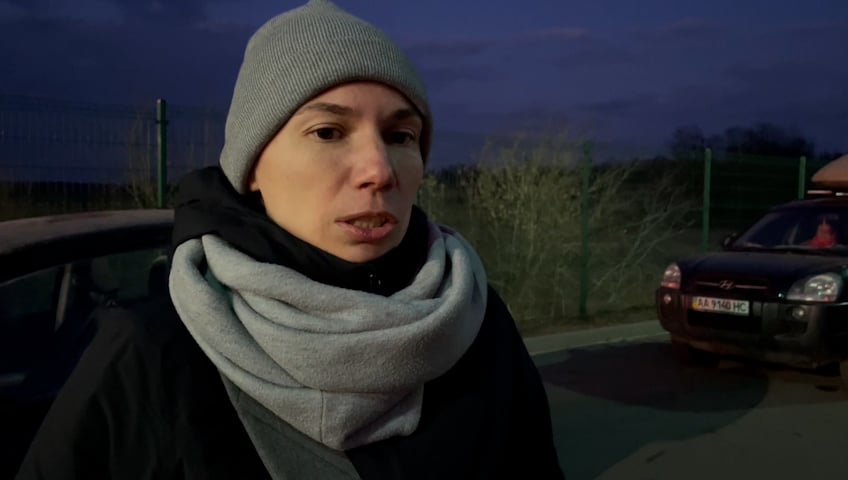By Chris Melzer at the Zosin border crossing, Poland | 27 February 2022
After a gruelling three-day car journey, Olga and her children are among hundreds of thousands who have fled Ukraine to find safety in neighbouring countries in recent days.
At the steel bridge over the river Bug that marks the border with Poland, a line of thousands of cars stretches back 14 kilometres into neighbouring Ukraine. Every few minutes a traffic light on the bridge turns green and a dozen vehicles pass through, putting an end to days of strain, uncertainty, and fear for those trying to reach safety.
“This is our third day on the road,” says Olga, 36, at the end of a journey that would usually take seven hours. She set out from Ukraine’s capital on Thursday with her two-year-old son and eight-year-old daughter, together with a neighbour and her daughter, and only arrived Saturday evening. “We fled as soon as the first bombs fell. It took us twelve hours just to get out of Kyiv. We’ve been [waiting] here for 36 hours now.”
“We fled as soon as the first bombs fell.”
Looking relieved to have reached the Polish border town of Zosin despite the visible exhaustion of the last few days, Olga explains they were not able to find a hot meal or a toilet during the entire journey.
“I’m sure others are worse off. And at least we are healthy,” she says, stroking her daughter Polina who is bundled in a thick coat, hat and scarf against the sub-freezing night-time temperatures, clutching a soft toy called “Foxy” that she brought from home. Asked how they coped in the car for three days, Olga replies simply: “We had no choice.”

Olga, 36, reaches safety in Poland three days after fleeing the Ukrainian capital Kyiv. © UNHCR
By Sunday, hundreds of thousands of people had already fled Ukraine into neighbouring countries since the start of the military offensive on 24 February. The largest numbers have headed west into Poland, with others entering Hungary, Moldova, Romania and beyond.
Refugees are being registered and provided with shelter by national authorities in the receiving countries, and UNHCR, the UN Refugee Agency, and its partners are on the ground at the main border areas across the region to support their efforts.
“[W]e have to record everyone’s identity,” says the commander of the Polish border guards at Zosin, indicating the long line of cars still waiting to enter. Those arriving without vehicles are able to avoid the queue of traffic and enter more quickly, he adds.
“Many just come on foot. Then they only have to wait four hours,” the officer says. “Sometimes buses come and drop people off a few kilometres before [the border]. Others drive to the border, abandon their car and come across.”
Behind him stands a large orange tent where people who have recently arrived are gathered, grateful for the offer of hot tea and pastries, fruit and sandwiches. Inside, a mother changes her baby, while nearby some children are crying as others run around playing, too young to understand what is going on.
“We are safe now…”
Back at the border, a father hugs his wife and children goodbye before turning back into Ukraine. Most of the refugees who have entered Poland are women and children.
After some food and a hot drink, Olga says she has no idea what lies in store for her and her children.
“Tonight we have accommodation just over the border, and then we’ll find something,” she says. “We are safe now, after all.”
Her biggest concern now is the safety of her husband back in Ukraine. “He stayed in Kyiv, donates blood all the time and takes care of the old people who couldn’t escape.” Asked what she hopes will happen now, Olga hugs her daughter and says: “That the bombs stop. That the killing stops. And that we can go home again.”